When I was nine, my parents took my younger sister and me to Disneyland. It was the kind of vacation every little girl dreams of – Main Street Parade, Sleeping Beauty’s Castle, pictures with Minnie Mouse, and a teeth-rotting amount of cotton candy.
I know, because there is visual proof of all these activities, carefully organized across my mother’s photo albums. But what do I really remember? What single thing from the vacation made that deep, visceral, never-going-to-forget-this impact that changes a kid’s life?
My sunburn.
I’ve been a Northwest girl for longer than I’ve been able to walk, and that California, Disneyland summer sun fried me to a crisp. Even slathered in SPF 10, or whatever skin protection was top-of-the-line in the mid-80s, over the course of a long day of cartoon idol-worship, I turned from my natural just-this-side-of-albinism pinkish pallor to bright scarlet. (If you are nerdy, think #FFFAF0 to #FE2E2E.)
I remember so clearly lying face down on the polyester bedspread of our hotel room. It was black with a Hawaiian flower motif. The bedspread looked shiny and smooth but any touch against my shoulders, chest, arms, or the tops of my feet was like a kiss from the cat o’ nine tails. Even weeks later, I was peeling patches of dead skin off the sunburnt areas.
That experience fused a conviction in my young mind: sun = evil.
And so, for the better part of 15 years, I hardly went outside. I’m not exaggerating. I didn’t play sports, I didn’t go camping, I didn’t hang out at the beach, and I sure as hell didn’t “tan”. In high school, while all the pretty girls got punch cards for strip mall tanning salons, I embraced my naturally porcelain skin as a statement. By this point I was watching My So-Called Life and Daria. I was wearing Dr. Martins and thought Ally Sheedy was cooler when she was wearing glasses and decorating her pictures with dandruff. The whole goth-look skin was part of the package.
Everything might have continued along this way had I not become a gardener and a mom. Now, between planting, playing, harvesting, weeding, and time at the park or beach, I spend a lot of time outside. I still try to cover up, hug the shady spots and stick to the cooler hours of the day, but my knee-jerk reaction to avoid the sun at all costs has changed.
My skin, unfortunately, has not.
Walking my son home from school yesterday (a 20 minute walk even at kid pace) led to a fairly painful sunburn across my shoulders. Luckily, I had a stash of Comfrey Cubes in the freezer.
Skin Soothing Comfrey Cubes
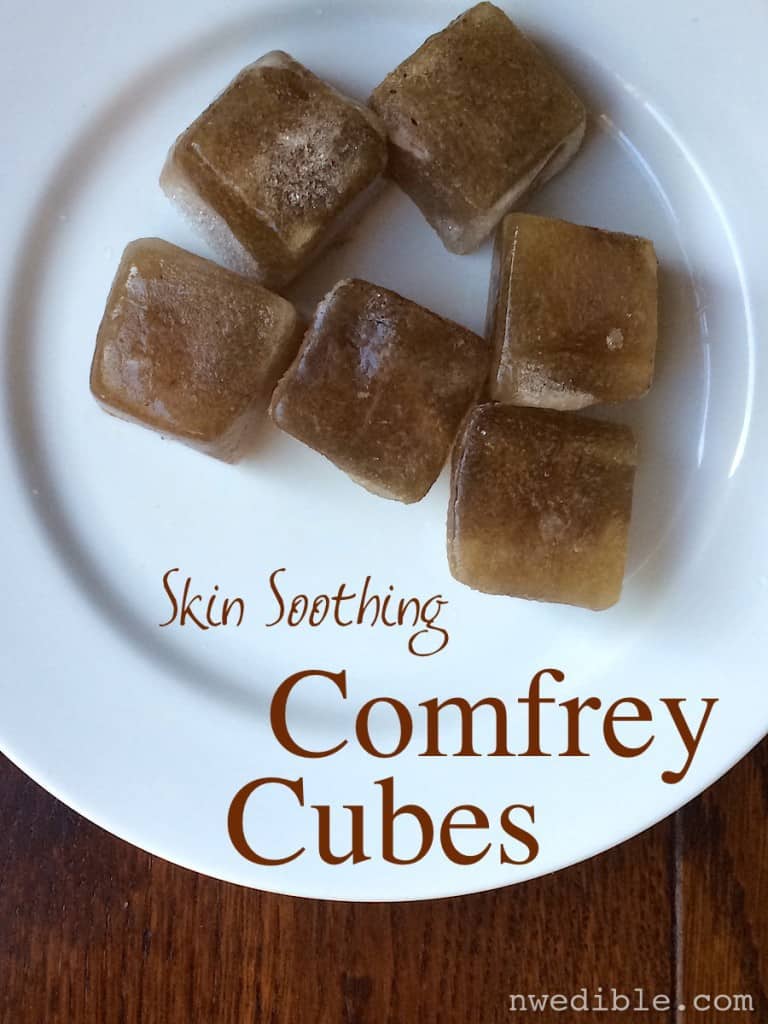
These cubes are my top pick for DIY emergency skin care. Comfrey (yes, the same plant that permies never shut up about. Just kidding, love you guys.) is phenomenally useful for skin care because it’s a rich source of allantoin, a compound that helps skin regenerate, soften, and recover from damage.
Allantoin is quite amazing. Wisegeek sums it up well:
Allantoin is odorless, safe, non-toxic, and non-allergenic in both natural and chemically synthesized form. When sold on its own for use in homemade soaps, lotions, and bath products, allantoin is a white, crystalline powder. It is moisturizing and keratolytic, meaning that it causes keratin in the skin to soften. This property helps skin to heal more quickly and to bind moisture more effectively, making products containing this substance useful for dry skin and for healing wounds, burns, and scars. It is also effective against sunburn, chapped lips, cold sores, diaper rash, and similar skin irritations.
Because of all that allantoiny goodness, these Comfrey cubes are useful for sunburns, regular burns, rashes, abrasions – pretty much any kind of non-puncturing skin damage. Every home should keep a stash on hand.
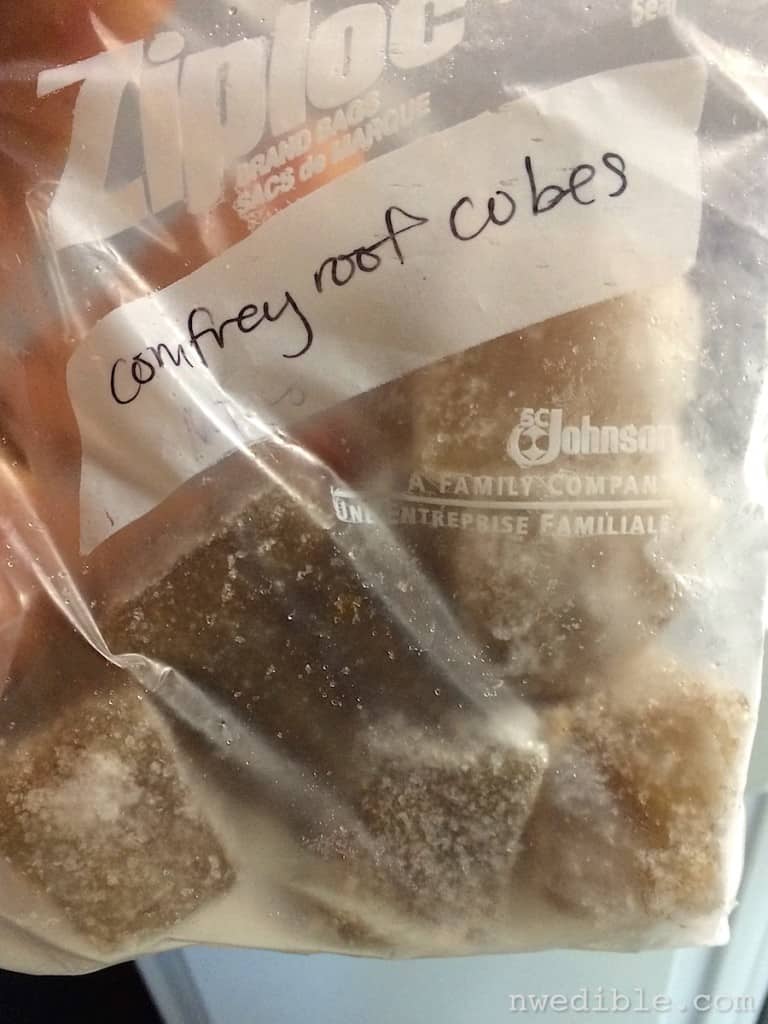
In my neck of the woods, comfrey is a common weed. When I need some, I just walk across the street and dig. The thick, fleshy roots are what we are after for the Comfrey Cubes, but the leaves are very useful in herbalism too.
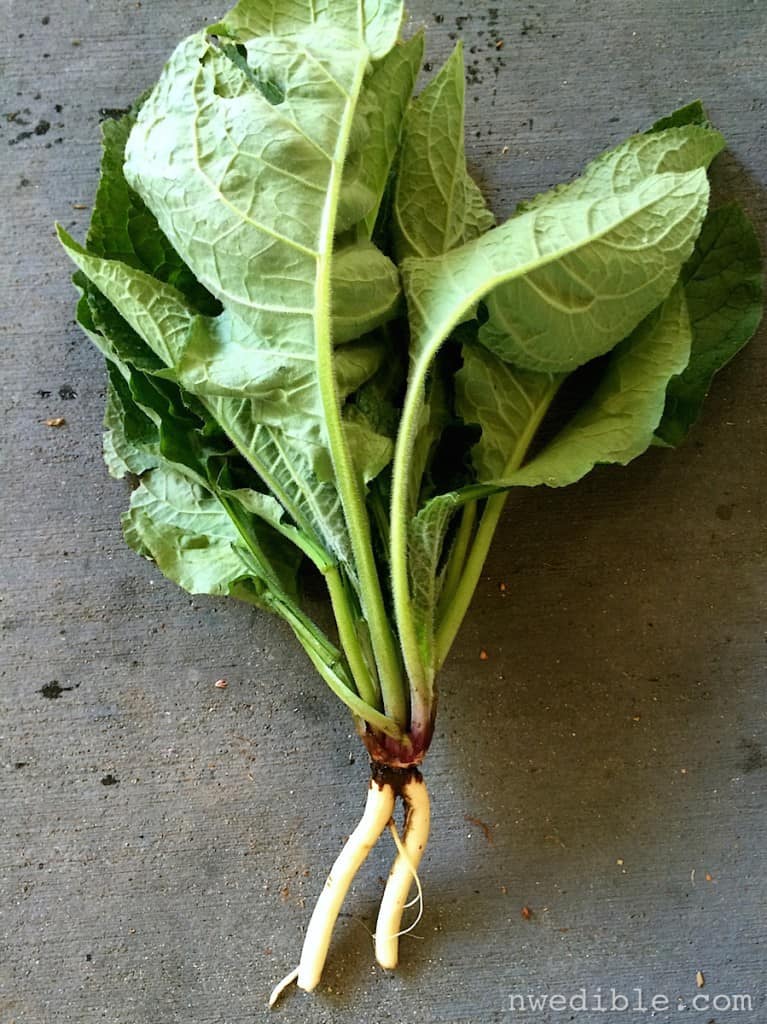
Familiarize yourself with this under-appreciated medicinal herb and you may start to see it everywhere, too. If you live someplace where comfrey isn’t available wild, you can substitute 1 oz of dried comfrey root, available online, for the fresh.
DIY Sunburn Soothing Comfrey Cubes
An allantoin-rich skin soother, these Comfrey Cubes are useful for sunburns, regular burns, rashes, abrasions, skin softening and healing. If fresh comfrey is unavailable, 1 oz. of dried comfrey root may be substituted. For external use only, do not take internally.
Ingredients
- 4 oz. fresh comfrey root
- 3 cups water
Instructions
- Very thoroughly scrub the comfrey roots, then chop them finely, by hand or in a food processor. Add the chopped comfrey root and the water to a medium saucepan. Bring to the barest simmer over medium-low heat, and maintain that temperature for 30 minutes. Remove comfrey gel from the heat, cover, and let cool completely, about 2 hours.
- When the comfrey gel has cooled, strain it through a very fine mesh strainer. It will be brownish and highly mucilaginous (goopy) - this is normal. Use a spatula to push as much of the comfrey mix through the strainer as possible without getting any root bits in the finished gel. You should have about 2 cups of comfrey gel when you are done.
- If you have a sunburn you can smooth a small amount of the comfrey gel right on your skin. To save the gel for later use, pour the cool comfrey gel into an ice cube tray (I use silicone trays like these) and freeze.
- When the comfrey cubes are frozen solid, transfer them to a freezer safe plastic bag, label the cubes so everyone knows they aren’t edible, and keep frozen.
- To use, rub a frozen Comfrey Cube directly onto sunburned skin.
Two words of warning
Any time you wildcraft (harvest medicinals or edibles from the wild) you must be absolutely, 100% certain of your plant identification. If you are uncertain, find an experienced herbalist who can show you what to look for before embarking on the wonderful adventure of wildcrafting.
Comfrey root is not for internal use. There are compounds in comfrey that can cause liver failure if taken in large doses internally. If you have any concerns about limited, external use of comfrey decoctions, talk to a qualified herbalist or doctor before using this gel.
13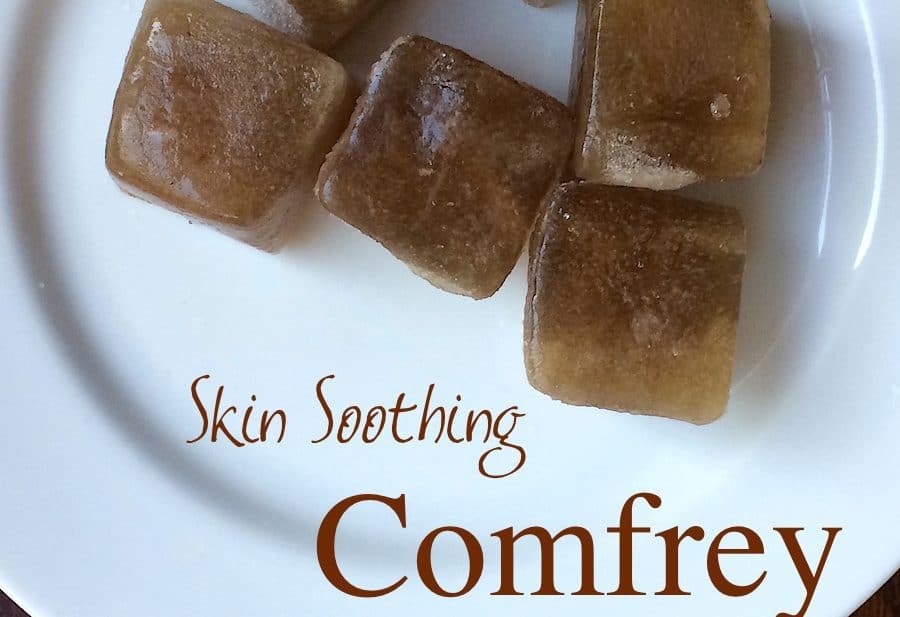
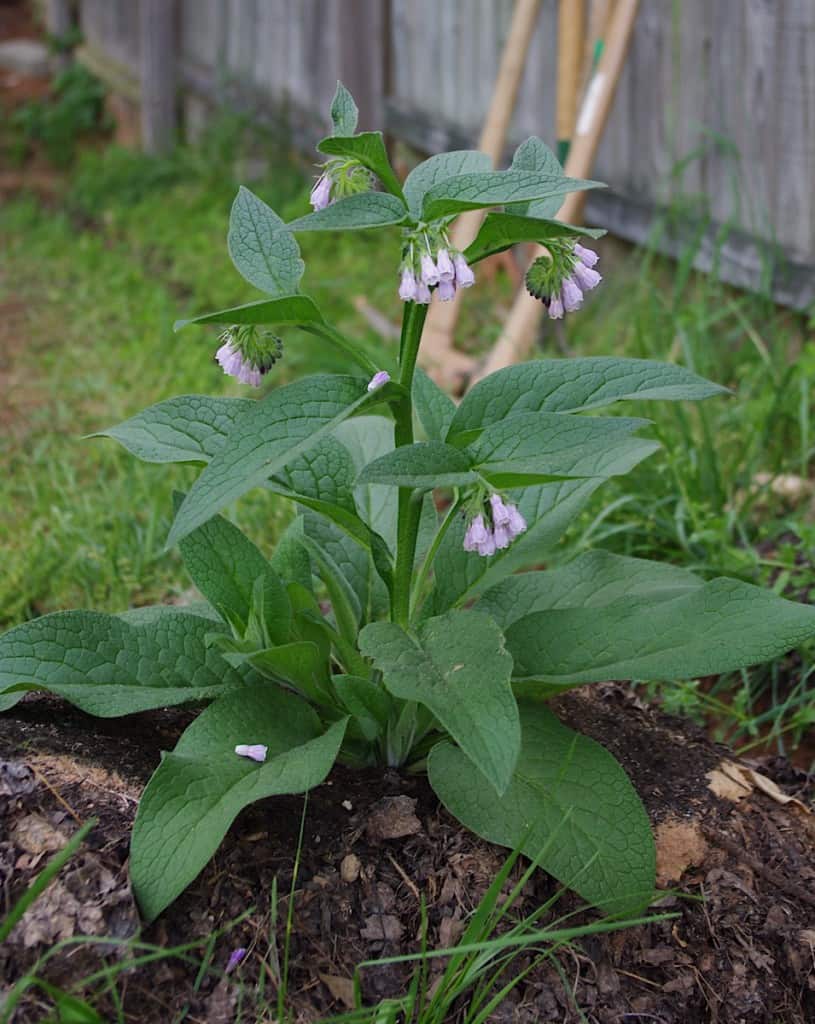
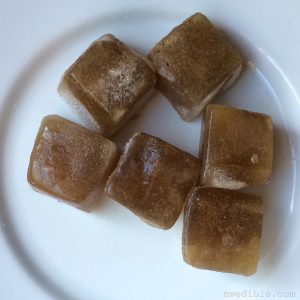
This sounds great as my husband and I are big cooks and we get burned all the time (and sunburned as well). Question though about the recipe. If I am using the dried comfrey, am I substituting 1oz for the entire 4oz of fresh or it is ounce for ounce (so 4oz of dried total). I have preordered your book and I cant wait to get it. Thanks.
Yeah this stuff is great for normal cooking/stove type burns too. 1 oz dried for the 4 oz. fresh. So, it would be an oz. of dried root and 3 cups water. And honestly, even that is more than enough comfrey root. You could do a bit less with no problem – the dried stuff is really potent.
Avoiding the sun for 15 years is why you look so young!
Well, that. Or maybe Photoshop. 😉
..that picture does not look like the comfrey around here, is it a local variety? ours have clusters of flowers, droopy like lampshades, your picture looks more like forgetmenots.. single flowers, no droop..
I screwed up on that photo. I’ve put in a better one – thank you!
Hello Erica! I had to tell you my story:) I was in the Gulf of Mexico on vacation, I am an avid shell collector so spent a long time at the beach looking for shells not realizing by back was getting baked! When we got back to the hotel we were horrified about our backs all I had was Hempz lotion – we smother it on and the burn sensation went away, no itching or peeling either!
Awesome! So glad you had a way to calm the burning.
Okay, I am now going to be on the lookout for comfrey! These ice cubes sound wonderful. Also, just preordered your book. 🙂 Can’t wait!
Right on, Emily! Thanks!
Now I’m curious to see if we have any of this growing around our “yard”. We’ve got every other imaginable weed hanging around, there must be some of this. The leaves look like some I’ve seen, but I don’t know if they’ve flowered like that. Tomorrow morning’s walk around the yard with the dog will be much more purposeful! (yes, I have to walk our dog around our property….he’s coyote appetizer size).
Barb
Oh no! No coyote snacking on your doggie!
I want to say I can’t wait to try this, but I totally can… I’ll have to make a batch anyway since I’ll invariably need it.
And I pre-ordered your book a couple weeks ago. Seems only right since I refer to you by first name and my husband says “oh, your bestie” every time I do so.
Thank you! I think you’ll like having these cubes on hand. 🙂
Great tip, I wonder if I can find that plant around here. And I pre-ordered your book last week. Hurry up September!
Thank you! I know, I’m so nervous about the launch. :/
Ok, question about comfrey… I planted two plants last year, Russian variegated comfrey. They are both thriving this year–big and lush. I know this plant has a reputation for being somewhat invasive, and I’ve read all the permie stuff about uses, but… I’ve been too nervous to “chop and drop” my lovely plant. And I’m not sure how soon I can divide it. I have it in a good spot where I don’t mind it spreading a bit, but so far it’s content to stay nicely where I put it. Any wisdom on how to convince it to spread out a bit? Should I divide it? Disturb the roots (I’ve read that’s a good way to get it to grow more)? Chop and drop and hope it comes back? Thoughts?
Can’t wait for the book! I’m another one guilty of using your first name in conversation, especially when talking to my husband. As in, “Erica says we should do _____ in the garden…”. He’s finally come around, somewhat, on the chickens. Pee in the garden is still under debate, though… Lol.
I know a common “Russian” is the Bocking 14 variety, which is sterile and doesn’t spread all over like the more wild varieties. Do you know if you have that kind? If so, no worries on out-of-control spread.
Here’s some info from Wikipedia that might help:
“Bocking 14 is sterile, and therefore will not set seed (one of its advantages over other cultivars as it will not spread out of control), thus is propagated from root cuttings. The gardener can produce his or her own “offsets” from mature, strongly growing plants by driving a spade horizontally through the leaf clumps about 7 cm (2.8 in) below the soil surface. This removes the crown, which can then be split into pieces. The original plant will quickly recover, and each piece can be replanted with the growing points just below the soil surface, and will quickly grow into new plants. When choosing plants to divide, ensure that they are strong healthy specimens with no signs of rust or mildew. When dividing comfrey plants, take care not to spread root fragments around, or dispose of on the compost heap, as each can re-root, and comfrey can be a very difficult plant to get rid of. Offsets can also be purchased by mail order from specialist nurseries in order to initially build up a stock of plants.”
Suggestion on siting? If they’re around here I’ve never spotted one. It’s on my list of seeds to get eventually.
Moist spots, like streamside or alongside irrigation ditches. Consider getting root offsets instead of seeds – you’ll get a better patch faster and you’ll be able to get the Bocking 14 variety that’s sterile so you won’t have to worry about invasiveness.
I definitely hear you on the horrific sunburns! When I was in high school, we moved from Chicago to NC, and suddenly I started getting sunburns during a 20-minute lunch period (usually on my feet, because who thinks to put on sunblock before putting on their sandals?). Now we live in CA and I have a stash of SPF 85 in constant rotation. I’ve never used comfrey before, but now I think I need to get my hands on some for backup sun relief!
Oh, yeah – those “sandal burns” are terrible. Or the ears! Another shockingly painful burn location.
I have some infused Comfrey oil, will it work the same if frozen? Thank you 🙂
What an interesting idea for the home pharmacy! For years I’ve just kept a bottle of commercial ‘aloe’ (term used loosely) post-sun lotion in the refrigerator. Very handy for kitchen burns and sunburns. I should make your comfrey cubes for my sister who used to get burns so badly she’d have giant blisters. That was back in the good old Coppertone 60’s when it was probably spf nothing.
Do you know what the blue flower that you posted by accident and replaced is? I have that blue flower growing in my entire yard, and I have been trying to identify it! The old version of your article showed up in my feedly, and when I clicked through I saw the photo was changed! I was so excited to have identified it.
Can I also use comfrey to heal dry skin? I tan easily, and it is unusual for me to burn, but my skin gets very dry. If it is good at rejuvenating skin cells, can it be made into a lotion or seeped in an oil for a healing lotion? If so, how do I store it so it doesn’t go bad?
I’m new to your website and suburban homesteading so this may be a silly question, but where can I get comfrey cuttings? I live in the pacific northwest similar to you and I’ve heard great things about comfrey and would love to start planting some.
I have a ulcer that I have had on my right leg since 2009.I have tried every thing but nothing works .I was told about the Cumfrey plant and would really like to give it a try .